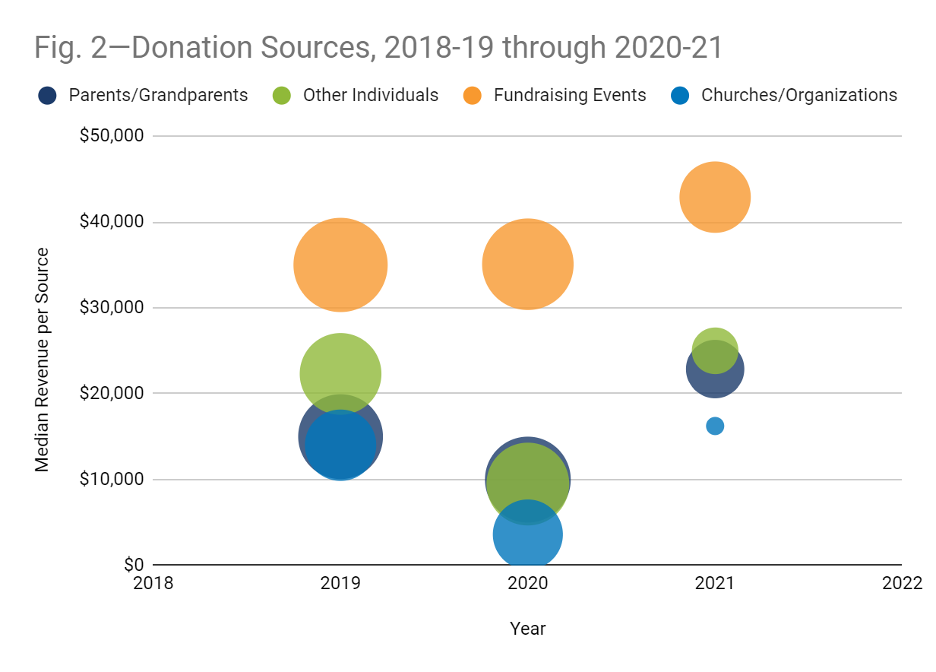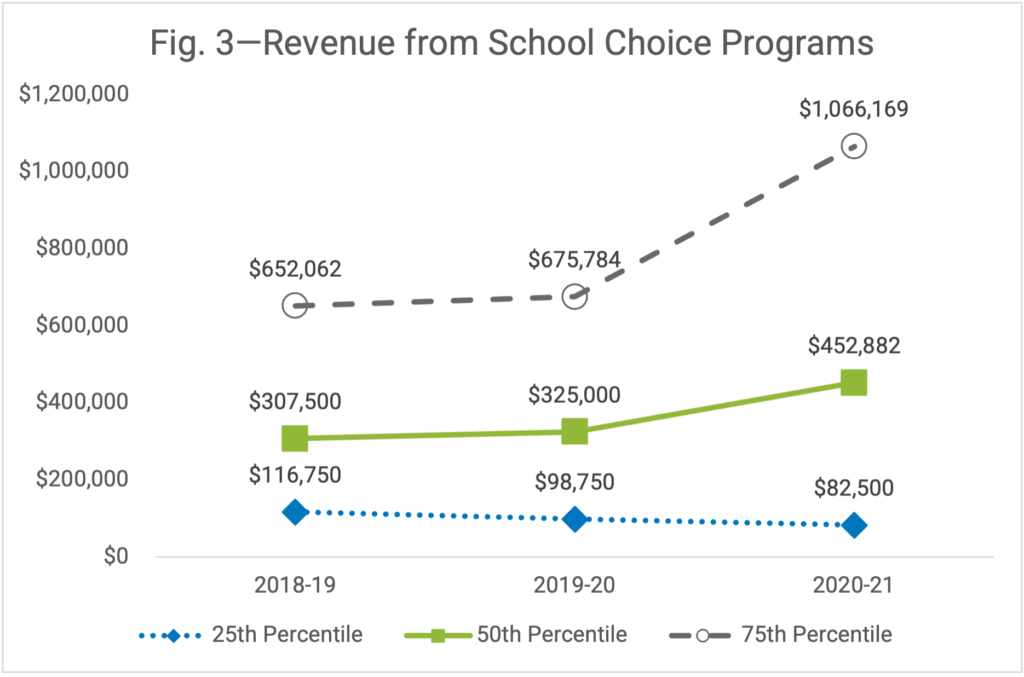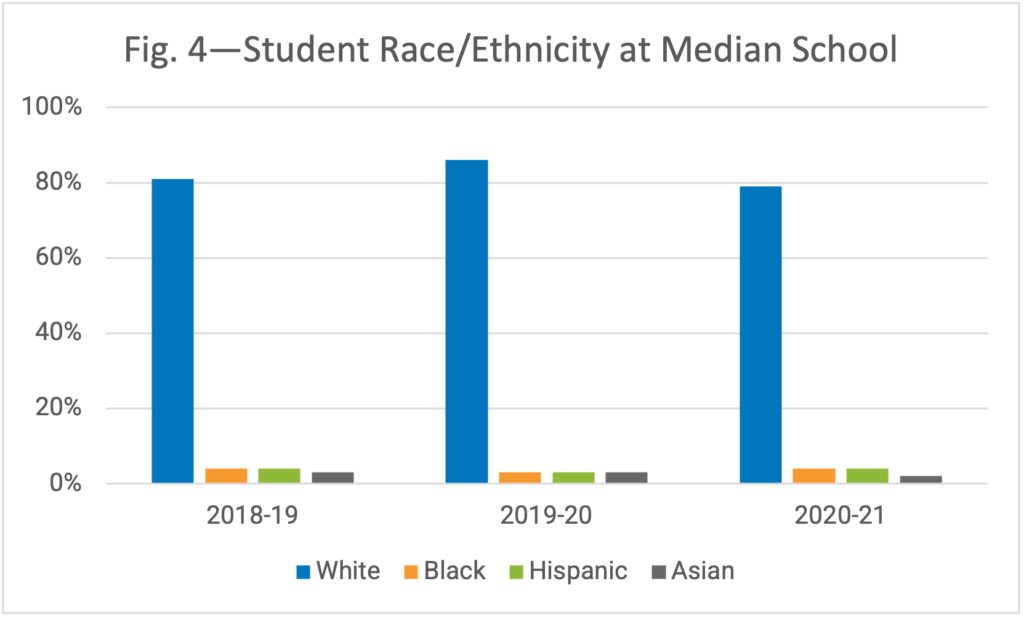Between March and July 2021, we asked ACSI schools to complete our Tuition & Salary Survey (member report available here). Overall, roughly 700 schools participated, a 24% response rate. With three years of data, we can glean helpful clues into some ways the coronavirus may have affected Christian schools. What did we learn?
First, operating budgets are rebounding.
Operating budgets were down during 2019-20. Overall (dotted blue line), operating budgets in 2019-20 were down about 10% relative to 2018-19. The schools with the smallest enrollments (green line) were most heavily affected, down nearly 25% compared to the median school in 2018-19.
Decreased operating budgets may not necessarily reflect decreased revenues, but prudent fiscal conservatism. In April 2020 (roughly one month after we fielded the 2019-20 T&SS), most respondents “indicated that their schools are budgeting for decreased enrollment.”
School budgets rebounded this past year. The median school of any size in our sample had an operating budget nearly 30% more than a comparable school in 2018-19. This is consistent with findings from the July 2020 COVID survey, in which two-fifths of respondents reported increasing their budget for 2020-21. But the smaller schools in our sample (gray and dark blue lines) had steadier climbs, and the smallest schools (green) may not have fully caught up (down 1% from 2018-19 at median).
Second, charitable giving is making a comeback.
 One possible explanation for lower budgets during 2019-20 is that donation revenues were down, perhaps due to economic uncertainties introduced by the global pandemic. In Figure 2, the size of the circle represents the proportion of respondents reporting each donation source (larger circles indicate a greater proportion of schools reporting that source). Some of the biggest charitable contributions to schools come through fundraising events (roughly 90% of schools reporting, at about $35,000 per source), which is encouraging because fundraising revenue held fairly constant during COVID, despite concerns expressed at the beginning of the school year.
One possible explanation for lower budgets during 2019-20 is that donation revenues were down, perhaps due to economic uncertainties introduced by the global pandemic. In Figure 2, the size of the circle represents the proportion of respondents reporting each donation source (larger circles indicate a greater proportion of schools reporting that source). Some of the biggest charitable contributions to schools come through fundraising events (roughly 90% of schools reporting, at about $35,000 per source), which is encouraging because fundraising revenue held fairly constant during COVID, despite concerns expressed at the beginning of the school year.
Major donation sources took a hit but jumped back generously. Median revenue from parents/grandparents ($10,000 per source), churches ($3,600), and other individuals ($9,477) all declined in 2019-20, but each source gave more generously in 2020-21 than before the pandemic ($22,870, $16,238, and $25,000 per source, respectively). This rebound is similar to overall patterns of charitable giving during the pandemic.
While giving amounts have returned generously, a smaller proportion of schools reports receiving donations from parents/grandparents (62% in 2020-21), churches/organizations (50%), and other individuals (56%), indicating that schools have not recovered some donors lost during COVID.
Third, school choice is on the rise.

An encouraging change is the growth of revenue from school choice programs, including education savings accounts, vouchers, and tax-credit scholarships. The median school in 2020-21 reported over 47% more revenue from these programs. There was even more growth at the 75th percentile, up 63% in 2020-21.
This growth is not surprising in a “breakthrough year” for school choice. Overall, 18 states created new or expanded existing options. Though only about 10% of all U.S. school-aged children are enrolled in faith-based private education, over a third of all U.S. adults say they would enroll their child in a private school if given a choice. These programs are giving more families that choice.
Proponents of school choice programs have long argued that a student’s educational opportunities should not be limited by place of residence. Perhaps the true legacy of the coronavirus for U.S. education is that it made clear that families need choices when it comes to their children’s education. The expansion of choice programs in 18 states strengthens the case that more states should do the same, for why should families in some states but not others be able to choose the best education for their children?

Despite breakthroughs in school choice programs, many of which are designed to increase access for historically underprivileged minorities to private schools, the student bodies of respondent schools remain relatively homogenous. Median enrollment for minority groups has remained level since 2018-19.
Why might an increase in school choice not correspond with a more diverse student body? For one, school choice revenues remain a relatively small income source in overall operating budgets. Blacks and Hispanics also favored remote schooling options, including homeschooling, during the pandemic, whereas the vast majority of ACSI schools were physically open for on-campus instruction.
Nevertheless, given the rapidly increasing diversification of the United States, it is worth asking why we are not seeing a commensurate change in Christian school enrollments over a three-year period—and how that might limit the potential for Christian schools to engage their communities as salt and light (Matthew 5:13-16).
Overall, trends are encouraging for the direction in which Christian schools are headed. We have evidence that operating budgets and charitable giving have rebounded after an off year, and in many states, school choice is expanding options, making Christian education more accessible for more families.
About the Author:
 Matthew H. Lee is director of Research at ACSI. He can be reached via email at matthew_lee@acsi.org and followed on Twitter @hmatthewlee.
Matthew H. Lee is director of Research at ACSI. He can be reached via email at matthew_lee@acsi.org and followed on Twitter @hmatthewlee.


